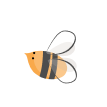- 5 months ago
Oral Thrush in Babies: What Causes It and How to Care for It at Home
What Is Thrush in Babies?
Oral thrush (medically known as oral candidiasis) is a fungal infection caused by Candida albicans. It appears as white, milk-like patches on the tongue, inner cheeks, roof of the mouth, or lips.
Unlike milk residue, thrush cannot be wiped away easily and may reveal red, irritated skin underneath.
Why Does Thrush Develop in Babies?
A newborn’s immune system is still developing, and any imbalance in the mouth’s natural flora can allow Candida to overgrow. Common causes include:
1. Passage Through the Birth Canal
If the mother has a vaginal yeast infection, it may be transmitted during delivery.
2. Antibiotic Use
Antibiotics taken by the baby or nursing mother can kill beneficial bacteria, allowing fungal overgrowth.
3. Poor Hygiene of Pacifiers, Bottles, or Nipple Shields
Improperly sterilized feeding tools can repeatedly introduce the fungus into the baby’s mouth.
4. Fungal Infection on the Mother’s Nipples
If the mother has itchy, red, burning nipples, the infection can pass back and forth between mother and baby.
How to Recognize Thrush in Babies
- White patches on the tongue, cheeks, or lips that don’t wipe off easily
- Discomfort or crying during feeding
- Reluctance to breastfeed or bottle-feed
- Increased drooling or unusual odor
- Breast refusal
In mild cases, your baby may continue feeding normally, but more severe cases can lead to weight loss or feeding difficulties.
Home Care and Hygiene Tips
Home care is important in both preventing and managing mild thrush.
Cleaning and Hygiene:
- Sterilize pacifiers, bottles, and nipple shields after every use
- After breastfeeding, wipe your nipples with plain water and let them dry completely
- Use sterile gauze to gently clean the baby’s mouth if advised by your pediatrician
Feeding Support:
- To make feeding easier, moisten your baby’s mouth before nursing
- Offer frequent, small feeds if your baby is fussy
Environment and Hand Hygiene:
- Wash hands thoroughly before and after touching the baby’s mouth or feeding equipment
- Ensure caregivers follow the same precautions
When Is Medical Treatment Needed?
Consult your pediatrician if:
- White patches are thick, widespread, or not improving after 5–7 days
- Your baby refuses to feed
- There are signs of weight loss or failure to thrive
- You suspect the infection is spreading
Commonly prescribed treatments:
- Nystatin oral drops or gel
- Miconazole gel (for older infants, under supervision)
Always use antifungal medication under medical supervision.
Should the Mother Be Treated Too?
Yes. If the mother shows signs of nipple thrush (itching, shiny skin, burning), both mother and baby should be treated together to prevent re-infection.
How to Prevent Oral Thrush
- Always maintain proper hygiene of feeding tools
- Avoid unnecessary antibiotic use
- Clean and dry nipples thoroughly after each feed
- Follow up with your pediatrician after any fungal episode to prevent recurrence













